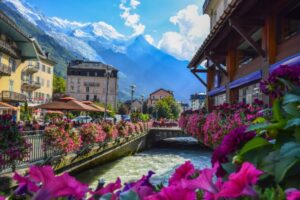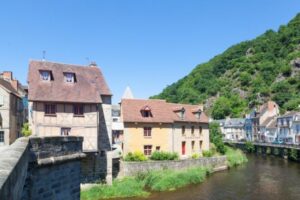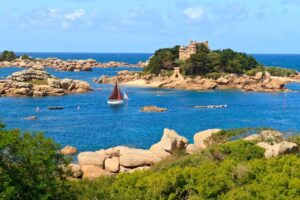Karen Tait looks at some of the wonderfully different locations in France and discovers there really is something for everyone
At around 2.3 times the size of the UK, there’s lots of France to explore in your hunt for a holiday or permanent home across the Channel. It’s also an extremely varied country, with everything from mountains to coast, cosmopolitan cities to sleepy villages, and rolling vineyards to dramatic river valleys. So here are some of the best places to buy if you’re looking for…

The pretty town of Aubusson is in France’s cheapest property area, Creuse from Shutterstock
A BARGAIN
Outside of pricey places like Paris and the Riviera, you’ll find a wide choice of affordable properties but if your budget really is squeezed, these are the three cheapest departments in which to buy a property.
Creuse: Within the Nouvelle-Aquitaine region, and the old region of Limousin, Creuse has the lowest property prices in France, with an average of €710/m² for houses. Sparsely populated and rural, Creuse is a farming area (mainly dairy and beef) with charming villages, lots of walking trails and rivers and lakes (including France’s largest leisure lakes, the Lac de Vassivière). The main towns are Guéret, Aubusson, La Souterraine and Bourganeuf and airports include Limoges and Brives.
Haute-Marne: Part of the old Champagne-Ardennes region, and now the larger Grand-Est region, Haute-Marne is another peaceful rural area with around 1,800km of waterways (great for fishing), huge forests and the odd champagne vineyard. The main towns are Chaumont, Langres (walled town) and St-Dizer, plus there are pretty villages like Joinville and Vignory, the spa town of Bourbonne-les-Bains, and several Renaissance castles. Closest airports are in Strasbourg and Basel-Mulhouse. The average house price is €840/m².
Meuse: Also part of the Grand-Est region, Meuse was previously in Lorraine and is known for World War I military tourism, with many cemeteries and memorials, including Verdun. The area also has beautiful medieval fortified churches and half-timbered houses, especially in the main town Bar-le-Duc, as well as Mognéville and Contrisson, while the numerous waterways, including the River Meuse, are popular for fishing. The closest airports are Paris and Strasbourg. The average house price is €890/m².
SUNSHINE
The south of France is where you’ll find the sunniest climate. The Riviera offers hot summers and mild winters, while the old Languedoc-Roussillon region, part of Nouvelle-Aquitaine, also has lovely summers but can be cold in winter, particularly in and close to the Pyrenees. Cross to the Atlantic side of France, and again you’ll have lovely long warm summers, although storms do sometimes come in from the ocean. Generally, anywhere south of the River Loire tends to offer warmer weather. The department of Vendée, in Pays-de-la-Loire, is often claimed to be the second sunniest area of France after the Cote d’Azur. Property prices are high in the south of France (€4,820/m² in Alpes-Maritimes) but reasonable in more rural areas.
TRADITIONAL LIFESTYLE
Most of rural France offers a traditional way of life for expats or holiday homeowners seeking a laidback lifestyle with lots of local flavour. The southwest, in particular, has proved popular with British househunters, including the perennial favourite Dordogne (average house price €1,470/m²) as well as departments such as Charente (€1,320/m²), Tarn-et-Garonne (€1,720/m²) and Lot (€1,520/m²). Here you’ll find lively market towns, picturesque villages, authentic gastronomy and scenery that ranges from gorges to vineyards to sunflower fields. Generally speaking, this covers the huge Nouvelle-Aquitaine region and neighbouring Occitanie (including the former regions of Aquitaine, Poitou-Charentes and Midi-Pyrenees).

The French Alps are as popular in summer as in winter from Shutterstock
CULTURE
Pick any French city and you’ll be spoilt for choice when it comes to culture, including art galleries, opera, theatre and cinema, as well as shops, markets, restaurants and nightlife. But you’ll also find fascinating local culture within the provinces, where local people are fiercely proud of their heritage and continue to speak local dialects. This includes Brittany in the north, an independent kingdom until 1532, or the Basque country at the other end of France.
YEAR-ROUND USE
While some more touristy destinations are undeniably quiet in winter, most places in France have a year-round population and are relatively active year-round, with cities obviously being busier than smaller towns and villages. Summer is, of course, when you’ll find most of the festivals, fetes, night markets and other activities, but winter too has its share of festivities with Christmas markets, light festivals and more. Arguably the best place for year-round use, however, especially for outdoor enthusiasts, is the Alps with its twin seasons. It’s popular for skiing and other snow sports in winter, and hiking, cycling, climbing and more in summer. All this makes it a great place to own a holiday home – and it’s also ideal if you want to bring in a holiday rental income. Prices can be high though, especially in the more sought-after resorts like Courchevel. Look further down the mountains for cheaper homes, in villages with links to the bigger ski stations. Average house prices are €2,830/m² in Savoie and in €1,180/m² in Haute-Savoie.
COAST
France has over 3,400km of coastline, from the wide sandy beaches and dunes of Pas-de-Calais in the north to the glamorous Cote d’Azur in the south. But some regions are rather more blessed in the coastal stakes. Brittany, for example, has more than 2,700km of coastline, with pretty bays, rocky inlets and stunning seaside towns – wherever you are in Brittany, you’re never far from the coast (average house prices from €2,157/m²). Or head south to the Landes department (average €2,400/m²) and you’ll find Europe’s longest beach at the 200km-long Cote d’Argent.

Brittany has some of France’s prettiest coastline and a strong independent culture from Shutterstock
EASY ACCESS
Northern France is ideal for those wanting a relatively short drive to their French home, with some eight ferry ports spread along the coasts of Nord-Pas-de-Calais, Normandy and Brittany (see our handy map on page 34). Then there’s the Channel Tunnel too, which not only enables people to take their cars to France with Eurotunnel but also offers the Eurostar trains service to Lille and beyond via connecting rail services. If you’re looking further south, consider locations close to an airport with flights to and from the UK – better still, a choice of airports. For example, Languedoc-Roussillon has five airports within its borders (Nimes, Montpellier, Beziers, Carcassonne and Perpignan) and Toulouse is also close by. Big airports like Bordeaux offer a wider choice of UK flights, while smaller airports such as Bergerac are very popular with Brits with homes in Dordogne, and others like Clermont-Ferrand (seasonal flights) have opened up areas previously quite difficult to access, in this case the Auvergne.
FRANCE AND A BIT MORE
If you love France but would also like access to other the culture and attractions of other European countries, one of the border regions might be perfect for you. For example, buy in Hauts-de-France (average house price €1,690/m²) and you can pop over to Belgium whenever you fancy; eastern Grand-Est (€1,540/m²) is perfect to access to Germany and in the French Alps you can ski over to Italy or Switzerland. The French Riviera merges into the Italian Med coast, while southern Occitanie and Nouvelle-Aquitaine both share the border with Spain.
To find out more and speak to agents in the area join us at the French Property Exhibition on the 27th and 28th January.
